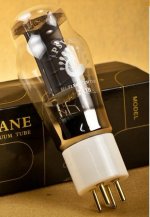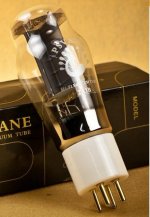Ok so at present i like the 45 over 2A3 in my Fi2A3 amp, however just came across the following RCA "replica" 2A3 tube which peaked my curiosity, of course if they do a 45 i'd have to try it. Google search came up with nothing, anyone here know anything about the Psvane WR2A3's?
2pcs New Psvane WR2A3 Vacuum Tube Matched Pair We and RCA Improved Type | eBay
2pcs New Psvane WR2A3 Vacuum Tube Matched Pair We and RCA Improved Type | eBay
Ok so at present i like the 45 over 2A3 in my Fi2A3 amp, however just came across the following RCA "replica" 2A3 tube which peaked my curiosity, of course if they do a 45 i'd have to try it. Google search came up with nothing, anyone here know anything about the Psvane WR2A3's?
I would avoid anything that company sells. Given some of their business practices, I would question what it is they actually deliver.
I've also been tempted to buy psvane products, they do look nice...
But Nasty things can happen with chinese tubes, internal shorts can at best take out bias resistors and at worst damage other expensive components, like your speakers if your using an OTL amp, some even come in a leaking state, and some just plain glow red and never bias properly.
If you can afford the output transformer for a 2A3 then I dont see why buying a good quality tested NOS 2A3 tube to go with it should be out of the question, or one from russia, especially considering psvane tubes are $99 whereas a tested NOS 2A3 is $20.
Is there something really that magical about RCA tubes that they need to replicate them and sell them for $438 a pair???!!!!
every few years a company starts in china claiming that their engineers worked at shugang or some such and as far as i can tell psvane have been around for about 2 years.
But Nasty things can happen with chinese tubes, internal shorts can at best take out bias resistors and at worst damage other expensive components, like your speakers if your using an OTL amp, some even come in a leaking state, and some just plain glow red and never bias properly.
If you can afford the output transformer for a 2A3 then I dont see why buying a good quality tested NOS 2A3 tube to go with it should be out of the question, or one from russia, especially considering psvane tubes are $99 whereas a tested NOS 2A3 is $20.
Is there something really that magical about RCA tubes that they need to replicate them and sell them for $438 a pair???!!!!
every few years a company starts in china claiming that their engineers worked at shugang or some such and as far as i can tell psvane have been around for about 2 years.
Last edited:
Well, it doesn't look like an older RCA 2A3, I have dozens of them, both gray and black plate plus some of the original single-plate RCA-Cunningham types. It seems to be a copy of the WE300B anode structure but not enough detail to say more.
To date, I've not seen any tested NOS 2A3 tubes selling in the $20 region, far from it. In any case, I've not seen or heard anything magical about the RCA 2A3 tubes (dual-section types). Hands down I prefer the older Sylvania types with the coil spring filament tension setup or the later fishing-rod filament tension setup over any of the RCAs. The build quality and robustness of the Sylvanias are much better.
Regards, KM
To date, I've not seen any tested NOS 2A3 tubes selling in the $20 region, far from it. In any case, I've not seen or heard anything magical about the RCA 2A3 tubes (dual-section types). Hands down I prefer the older Sylvania types with the coil spring filament tension setup or the later fishing-rod filament tension setup over any of the RCAs. The build quality and robustness of the Sylvanias are much better.
Regards, KM
That advertisement is nothing more than marketing glitz: those tubes are nothing like a RCA 2A3. If you want a super 2A3 with a 300B plate you should consider the JJ 2A3-40 for a $200 savings over the Chinese. I have been using these for about 6 months and am very pleased. They work great at 300V @ 65mA.
The older RCA 2A3's were single-plates, basically a smaller 300B. The single-plate RCAs go for a ridiculous sum of money at the popular auction sites. I don't know why 2A3 eventually became dual-plates, like two parallel 45s, as it is a strange design. Making modern production 2A3's single plate is a good design decision IMHO.
That JJ 2A3-40 I have, is really a 300B plate. It sounds just like my 45's, except it gobbles up 2.7A of current for its filament.
You can operate a 45 (12W dissipation) at 2A3 levels and get the same power, which renders the 2A3 pointless. 5W at 5% distortion has been measured with the 45. If you don't need your tubes to last many years, this is the way to go.
That JJ 2A3-40 I have, is really a 300B plate. It sounds just like my 45's, except it gobbles up 2.7A of current for its filament.
You can operate a 45 (12W dissipation) at 2A3 levels and get the same power, which renders the 2A3 pointless. 5W at 5% distortion has been measured with the 45. If you don't need your tubes to last many years, this is the way to go.
In any case, I've not seen or heard anything magical about the RCA 2A3 tubes (dual-section types).
Yeah, too much hype. Not a bad tube but nothing to go crazy over.
The older RCA 2A3's were single-plates, basically a smaller 300B. The single-plate RCAs go for a ridiculous sum of money at the popular auction sites. I don't know why 2A3 eventually became dual-plates, like two parallel 45s, as it is a strange design. Making modern production 2A3's single plate is a good design decision IMHO.
That JJ 2A3-40 I have, is really a 300B plate. It sounds just like my 45's, except it gobbles up 2.7A of current for its filament.
You can operate a 45 (12W dissipation) at 2A3 levels and get the same power, which renders the 2A3 pointless. 5W at 5% distortion has been measured with the 45. If you don't need your tubes to last many years, this is the way to go.
Yes, single-plate 2A3 tubes go for large sums these days. Being a true single triode, it should have an edge over a dual-plate version (which is two triodes in parallel). The latter was created as it was cheaper and faster to manufacture (and with better yield most likely). Take a close look at the filament structure in the original single-plate version and it becomes obvious. Also note that the single-plate is more fragile and can not handle any real additional plate dissipation over the 15-watt spec, while a good robust made dual-section type can run at 18 watts and not see any red.
As for a 45 replacing a 2A3, it doesn't... you can push it (the 45) to around 11 watts dissipation with good airflow, but you won't likely get more than 2.5-watts (class A1) from it. I've yet to see any A1 operating point that gets 5-watts from a 45... care to share? Besides, why purposely trash a nice triode for a few dB at most? I certainly wouldn't recommend it. That being said, I do run mine around 10-watts dissipation (~300 volts @ 34ma) and get ~2.25watts output. Note that 300 volts and 10 watts is an uprated spec which was later published with ST glass versions.
Regards, KM
a few years ago, wasn't there also introduced a fine expencive 2A3 tube running on 6.3V filament ?
would that be other than a 'changed' 6A3 ?
Can't vouch for new production, many of which are called one type but really have nothing in common beyond the type number. There is a 6A3 and also the 6B4G (same as a 6A3 with an octal base). Then there's the 45 Special, which is a larger single plate triode (more of a 2A3 size) with a 6.3 volt filament. Some swear that they are truly special, but I've not had a pair to play with, so I can't comment.
One note of interest, the 6B4G is typically implemented the same as a dual plate 2A3 grid/anode/filament structure. The difference is in the filament, where the 2A3 has both filaments wired in parallel, the 6B4G has them wired in series. This is significant change... I have but one pair of 6B4G tubes where they are wired in parallel, Raytheon, true dual (separate) triodes and true parallel operation. In short, an AC filament supply won't work very well with the 6B4G series-wired filaments.
Regards, KM
- Status
- This old topic is closed. If you want to reopen this topic, contact a moderator using the "Report Post" button.
- Home
- Amplifiers
- Tubes / Valves
- Psvane Replica RCA 2A3 tube - WR2A3

